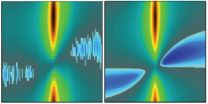MASER stands for Microwave Amplification by Stimulated Emission of Radiation. Devices based on this process (and known by the same acronym) were developed by scientists more than 50 years ago, before the first LASERs were invented. Instead of creating intense beams of light, as in the case of LASERs, MASERs deliver a concentrated beam of microwaves.
Conventional MASER technology works by amplifying microwaves using hard inorganic crystals such as ruby, this process is known as "masing". However, the MASER has had little technological impact compared to the LASER because getting it to work has always required extreme conditions that are difficult to produce; either extremely low pressures, supplied by special vacuum chambers and pumps, or freezing conditions at temperatures close to absolute zero ( -273.15°C), supplied by special refrigerators. To make matters worse, the application of strong magnetic fields has often also been necessary, requiring large magnets.
Now, the team from the National Physical Laboratory (NPL) and Imperial College London have demonstrated masing in a solid-state device working in air at room temperature with no applied magnetic field. Today's breakthrough means that the cost to manufacture and operate MASERs could be dramatically reduced, which could lead to them becoming as widely used as LASER technology.
The researchers suggest that room-temperature MASERs could be used to make more sensitive medical instruments for scanning patients, improved chemical sensors for remotely detecting explosives; lower-noise read-out mechanisms for quantum computers and better radio telescopes for potentially detecting life on other planets.
Dr Mark Oxborrow, co-author of the study at NPL, says: "For half a century the MASER has been the forgotten, inconvenient cousin of the LASER. Our design breakthrough will enable MASERs to be used by industry and consumers."
Professor Neil Alford, co-author and Head of the Department of Materials at Imperial College London, adds: "When LASERs were invented no one quite knew exactly how they would be used, and yet the technology flourished to the point that LASERs have now become ubiquitous in our everyday lives. We've still got a long way to go before the MASER reaches that level, but our breakthrough does mean that this technology can literally come out of the cold and start becoming more useful."
Conventional MASER technology using hard inorganic crystals such as ruby, only works when the ruby is kept at a very low temperature. The team in today's study have discovered that a completely different type of crystal, namely p-terphenyl doped with pentacene, can replace ruby and replicate the same masing process at room temperature.
As a curious twist, the pentacene dopant turns the otherwise colourless p-terphenyl crystal an intense reddish pink – making it look just like ruby!
The twin challenges the team currently face are getting the MASER to work continuously, as their first device only works in pulsed mode for fractions of a second at a time. They also aim to get it to operate over a range of microwave frequencies, instead of its current narrow bandwidth, which would make the technology more useful.
In the long-term, the team have a range of other goals including the identification of different materials that can mase at room temperature while consuming less power than pentacene-doped p-terphenyl. The team will also focus on creating new designs that could make the MASER smaller and more portable.
INFORMATION:
The research was funded by the Engineering and Physical Sciences Research Council and, at NPL, through the UK's National Measurement Office (NMO).
Media contacts:
David Lewis
Proof Communication
Email: david@proofcommunication.com
Tel: +44 (0) 845 680 1865
1. "Room-temperature solid-state maser", published Nature 16 August 2012
Download a copy of the paper: http://www.nature.com/nature/journal/v488/n7411/full/nature11339.html
The full listing of authors and their affiliations for this paper is as follows:
Mark Oxborrow1, Jonathan D. Breeze2, and Neil M. Alford2
1 National Physical Laboratory, Teddington, UK
2 Imperial College London, UK
2. About The National Physical Laboratory (NPL)
The National Physical Laboratory (NPL) is one of the UK's leading science facilities and research centres. It is a world-leading centre of excellence in developing and applying the most accurate standards, science and technology available.
NPL occupies a unique position as the UK's National Measurement Institute and sits at the intersection between scientific discovery and real world application. Its expertise and original research have underpinned quality of life, innovation and competitiveness for UK citizens and business for more than a century: NPL provides companies with access to world leading support and technical expertise, inspiring the absolute confidence required to realise competitive advantage from new materials, techniques and technologies NPL expertise and services are crucial in a wide range of social applications - helping to save lives, protect the environment and enable citizens to feel safe and secure. Support in areas such as the development of advanced medical treatments and environmental monitoring helps secure a better quality of life for all NPL develops and maintains the nation's primary measurement standards, supporting an infrastructure of traceable measurement throughout the UK and the world, to ensure accuracy and consistency.
Website: www.npl.co.uk
3. About Imperial College London
Consistently rated amongst the world's best universities, Imperial College London is a science-based institution with a reputation for excellence in teaching and research that attracts 14,000 students and 6,000 staff of the highest international quality. Innovative research at the College explores the interface between science, medicine, engineering and business, delivering practical solutions that improve quality of life and the environment - underpinned by a dynamic enterprise culture.
Since its foundation in 1907, Imperial's contributions to society have included the discovery of penicillin, the development of holography and the foundations of fibre optics. This commitment to the application of research for the benefit of all continues today, with current focuses including interdisciplinary collaborations to improve global health, tackle climate change, develop sustainable sources of energy and address security challenges.
In 2007, Imperial College London and Imperial College Healthcare NHS Trust formed the UK's first Academic Health Science Centre. This unique partnership aims to improve the quality of life of patients and populations by taking new discoveries and translating them into new therapies as quickly as possible.
Website: www.imperial.ac.uk
END


